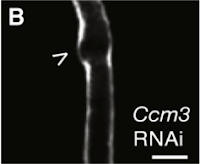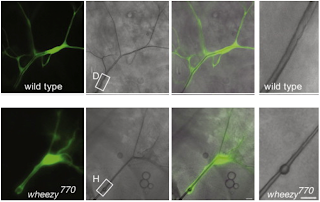This is my first blog post but I hope to contribute more in the future (about my work on dendrite maintenance in the Parrish laboratory). Today’s post is about the work I did prior to starting graduate school at UW. Once upon a time I joined Amin Ghabrial’s laboratory at the University of Pennsylvania as a technician. Before that, I honestly had not given much thought to tubes. I remember the first time a straw failed me (it had a hole in it), and I remember feeling rather betrayed. Luckily straws are replaceable; the tubes running through our bodies though are not, therefore we better learn about and take good care of the ones we have.

Some of the most important tubes in the human body are the capillary tubes that allow for separation of blood and brain fluid (known as the blood-brain barrier). In Cerebral Cavernous Malformation, a hereditary disorder that causes migraines, seizures, and even stroke-induced death, this barrier is compromised as a result of dilated and leaky capillary tubes[1]. The thinnest capillary tubes are often of seamless nature, and are difficult to study by default because of their small size and physical inaccessibility. Luckily we can use model organisms to explore tube formation and maintenance. To the right is a schematic of tracheal cells representing two ways that a single cell can make a tube.
During my two years in the Ghabrial laboratory studying tracheal system development in Drosophila melanogaster I became ever more thankful that the tubes I use to breathe, pump blood, and poo all work. At the same time, I learned to love the fruit fly as a model organism and to marvel at the power of molecular genetics as tools for biological inquiry. Thanks to translucent larvae, high-powered microscopy, and techniques for mosaic analysis, we can look at the effect of one gene’s misexpression on one cell or a small subset of cells in a healthy live animal. This way we can get at cell specific mechanisms of action. I mean come on! If that’s not cool I don’t know what is.

Mutation of the gene CCM3 is one way CCM can manifest, and I studied the effect of this and a few other genes’ misexpression in fruit fly trachea. I had the great pleasure of working closely with Yanjun Song and Amin on this project, and I am so grateful they included me as 2nd author on this paper. Our work, “Focal Defects in Single-Celled Tubes Mutant for Cerebral Cavernous Malformation 3, GCKIII, or NSF2”, was published in the June 10, 2013 issue of Developmental Cell. We showed that CCM3 and GCKIII, also referred to as wheezy in the paper (a line recovered from Amin’s mutant screen at Stanford, no relation to Lil Wayne) genetically interact. As shown here (inset), wild type tracheal cells should be of uniform diameter and have specific morphology.
Tracheal cells missing GCKIII and tracheal cells missing CCM3 display a large tubular dilation. To say that two genes “interact” means that misexpression of both together cause a more severe defect (in this case frequency of dilations) than that seen by loss of either gene alone. We did see this relationship between CCM3 and GCKIII. Yanjun also goes on to show several different ways that re-supplying these proteins in only the trachea reduce dilations, and that loss of apical and septate junction proteins can also repress tube dilation. Excitingly these results can now be tested in vertebrate and mammalian systems, and hopefully CCM patients can benefit from this research someday. I certainly have benefited from doing this research; I gained some good Leica microscopy skills, I learned how to make knockout mutants using P-element mobilization, learned how to survive minor existential crises when data turn out weird or scoopage is a possibility, but most importantly I learned that sharing science is extremely important. I was lucky to have great mentors and feel encouraged to ask questions when learning about diverse research. Seamlessly now that I’m at UW I feel that same strong sense of scientific community. So NB to my fellow grads: I may go MIA for several weeks at a time, but it’s because I am working hard and the clouds can make me forget how to socialize, but trust me when I say: UW Biology rocks and I am so happy to be here! Flygirl out.
-Melissa Eng

And here’s the paper!


